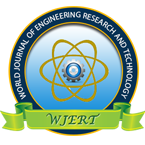| All | Since 2020 | |
| Citation | 172 | 110 |
| h-index | 7 | 5 |
| i10-index | 1 | 0 |
WJERT Citation 
Login
News & Updation
Abstract
32.76 % (36.14 %)- HIGHEST EFFICIENCIES IN -ALLOY JUNCTION SOLAR CELLS AT 300 K, ACCORDING TO HIGHEST HOT RESERVOIR TEMPERATURES, 446.2 K (469.8 K), OBTAINED FROM CARNOT-EFFICIENCY THEOREM. (IX)
Prof. Dr. Huynh Van Cong*
ABSTRACT
In -alloy junction solar cells atT=300 K, , by basing on the same physical model and thesame treatment method, as those used in our recent works[1, 2], we willalso investigate the maximal efficiencies, , obtained at theopen circuit voltage according to highest hotreservoir temperatures, , obtained from the Carnot efficiencytheorem, which was demonstrated by the use of the entropy law. In thepresent work, some concluding remarks are given in the following. (1)In the heavily doped emitter region, the effective density of electrons(holes), , given in parabolic conduction (valence) bands, expressedas functions of the total dense impurity density, , donor (acceptor)-radius, , and x-concentration, is defined in Eq. (9d), as:), where is the Mott critical density in themetal-insulator transition, determined in Eq. (9a). Then, we have showed that (i) the origin ofsuch the Mott’s criterium, Eq. (9a), is exactly obtained from the reduced effective Wigner-Seitz radius , characteristic of interactions, as given in Equations (9b, 9c), and further(ii) is just the density of electrons (holes) localized in the exponential conduction(valence)-band tail (EBT) as that demonstrated in.[1] (2) In Table 3n, for the alloy junction solar cell and for -radius, one obtains with increasing x=(0, 0.5, 1): = 23.24 %, 29.55 %, 32.76 %, according to at , respectively.(3) In Table 5p, for the alloy junction solar cell and for -radius, one obtains with increasing x=(0, 0.5, 1): = 36.14 %, 34.24 %, 32.34 %, according to at , respectively.
[Full Text Article] [Download Certificate]
